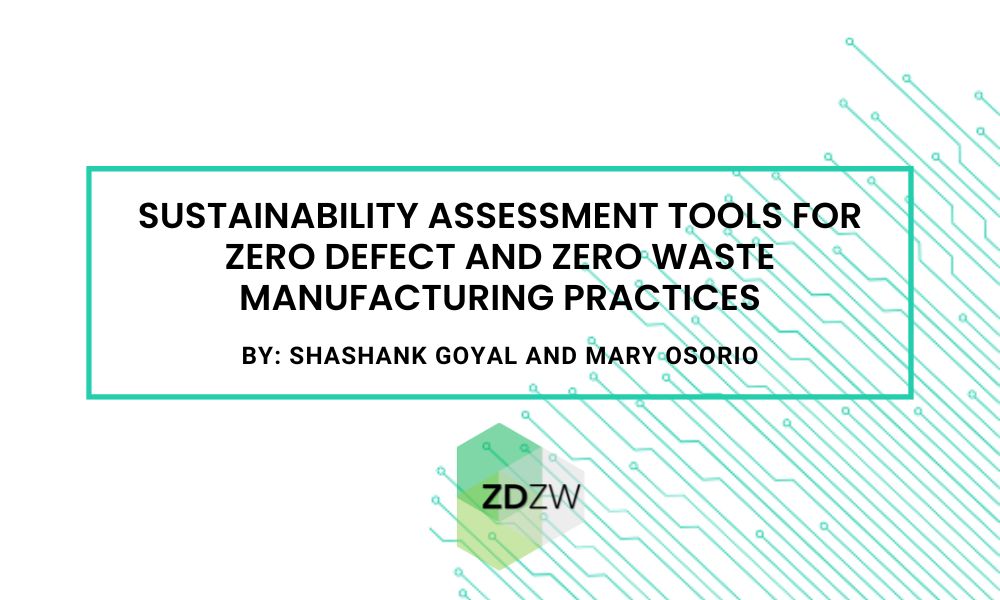
Sustainability assessment tools for zero defect and zero waste manufacturing practices
Introduction
Have you ever wondered how to assess a project’s overall sustainability? What are sustainability assessment tools? Want to understand how the ZDZW project achieves sustainability? You’re in the right place!
In this blog, EurA AG’s sustainability experts, Shashank Goyal and Mary Osorio, will share their knowledge. They’ll discuss tools and techniques used for sustainability assessments.
What is a Sustainable Project?
First, let’s define a sustainable project. A sustainable project is a profitable business model that emphasizes environmental and social responsibility.
In contrast, Zero Defects and Zero Waste (ZDZW) is a groundbreaking approach in manufacturing. It combines innovation and sustainability by using smart technologies like Non-Destructive Inspection (NDI). NDI checks products without damaging them, ensuring quality from the start. This reduces waste, saves raw materials, and cuts costs. Look at how ZDZW is improving quality in the mass production of plastic parts.
Life Cycle Assessment (LCA)
Life Cycle Assessment (LCA) is one of the sustainability assessment tools that measures a product’s ecological footprint, according to DIN EN ISO 14040:2006 and DIN EN ISO 14044:2006. It covers the entire life cycle—from raw material extraction to production, transportation, use, and disposal.
LCA evaluates resource consumption, emissions, and environmental impacts to pinpoint ecological hotspots. It provides insights into effects like GHG emissions, water footprint, and land use. This helps organizations optimize their value chain and make more environmentally friendly products. These results can also serve as a unique selling point (USP).
LCA involves four main phases:
- Goal and Scope Definition: Define the objectives and scope of the analysis, including the target question.
- Inventory Analysis: Collect data on inputs (e.g., raw materials, energy) and outputs (e.g., by-products, waste).
- Impact Assessment: Model the collected data to compute ecological impacts for the entire life cycle. Tools like Ecoinvent and software like SimaPro assist in this.
- Interpretation: Transform data into actionable knowledge to answer the study’s target question.
Life Cycle Cost (LCC)
Life Cycle Cost (LCC) is a sustainability assessment tool that sums up all costs throughout a product’s life cycle. It helps decision-makers choose the most cost-effective investment plan. Environmental LCC is often used alongside LCA, using the same scope and functional unit.
The steps for LCC are:
- Goal and Scope Definition
- Data Collection
- Impact Assessment
- Interpretation and Sensitivity Analysis
LCC is expressed as: LCC = IC + OC + MC + DC + EC (Andrae et al., 2004). Here, IC is the initial investment cost, OC is the operating cost, MC is the maintenance cost, DC is the disposal cost, and EC is the external environmental cost.
EC covers costs for preventing or mitigating environmental damage, such as air quality, climate protection, and biodiversity. LCC bridges sustainability and profitability by evaluating costs at each life cycle stage.
For instance, high-quality technologies like NDI might have higher initial costs. However, LCC shows long-term benefits like reduced defects, longer lifecycles, and lower maintenance costs. In an ideal scenario, the higher initial price for NDI technology is offset by reduced usage and disposal costs.
Social Impact Assessment (SIA)
Social Impact Assessment (SIA), according to UNEP, is a sustainability assessment tool involves managing the social consequences of projects—both positive and negative. The goal is to avoid harm and maximize benefits for society.
Various methodologies exist for SIA, mixing quantitative and qualitative techniques. Key elements in every SIA include:
- Definition: Clarify the plan, policy, or intervention.
- Stakeholder Identification: Identify and prioritize the main stakeholders affected.
- Impact Identification: Determine potential social impacts.
- Impact Estimation: Estimate the consequences of these impacts.
- Remediation Plan: Develop a plan to address negative impacts.
- Monitoring Program: Implement a program to track outcomes.
In the ZDZW project, SIA will focus on integrating technology in six European industries. Workers have been identified as the primary stakeholders and the group most affected. The assessment will center on labor impacts, including job changes and new job profiles from integrating new technologies.
ZDZW will use a participatory approach for SIA, involving workers in the assessment process. This ensures the most relevant impacts are considered and helps create effective mitigation actions. It also empowers workers to contribute to smoother technology integration and acceptance.
Conclusion
The ZDZW project applies all three sustainability assessments to its six pilots. These pilots span strategic sectors like automotive, home appliances, renewable energy, e-health, and food and beverages. They cover various industrial processes, including injection molding, thermoforming, welding and painting, induction hardening, lithography, and packaging.
